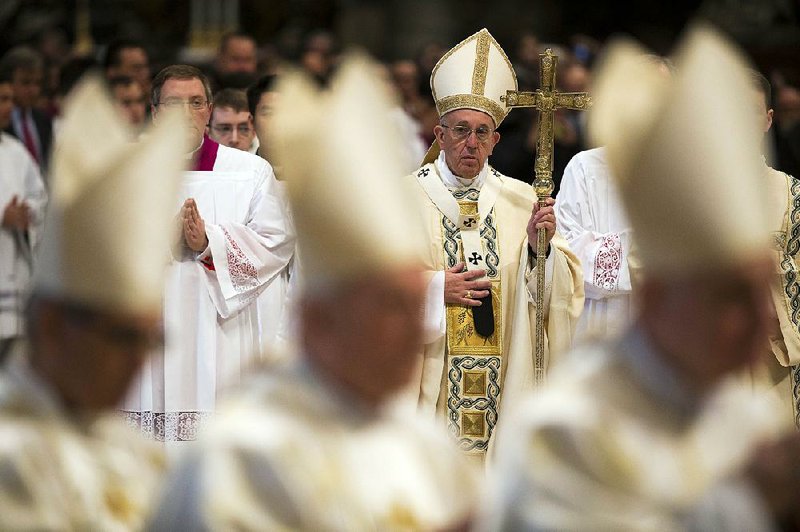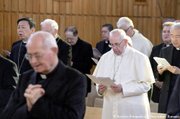Pope Francis last week signaled receptiveness to appeals from bishops in the remote and overwhelmed corners of the Roman Catholic Church to combat a deepening shortage of priests by ordaining married men who are already committed to the church.
In an interview with a German newspaper, the pope made clear that he was not advocating an end to celibacy for current priests or those aspiring to join the clergy. But his seeming openness about the prospect of ordaining married men in places hardest hit by a dearth of priests was unusually explicit and brought the issue to the forefront.
"We need to think about whether 'viri probati' could be a possibility," Francis, using the Latin phrase for such "tested" men, said in Die Zeit. "If so, we would need to determine what duties they could undertake, for example, in remote communities."
For years, the pope has noted that an element of married clergy exists in the church. Eastern Rite priests in union with Rome have married for centuries. In 1980, John Paul II created a provision by which some married Protestant ministers who converted to Catholicism could maintain their ministry. And historically, priests in the first centuries of the church were free to marry.
But monastic influences at the turn of the millennium led to the adoption of a celibacy requirement at the First Lateran Council of 1123, and that tradition has held ever since. It is not doctrine or dogma, but instead a code of canon law that essentially reasons that priests unburdened by spouses or children are more reflective of Christ and devoted to pastoral demands.
Francis, who has made clear that he sees little possibility of allowing women to be priests, called the vocation crisis an "enormous problem."
The issue is less a question of theology than arithmetic.
In the United States, there are about 2,500 Catholics per priest, compared with 851 per priest in 1972, according to the Center for Applied Research in the Apostolate, which is affiliated with Georgetown University.a
The chasms are far wider in Africa, Asia and Latin America, where the faithful can go months without access to a priest and married deacons are increasingly called on to conduct the business of parishes. In Brazil, according to the center, there are roughly 8,000 Catholics per priest.
The Rev. Thomas J. Reese, a Jesuit priest and senior analyst for The National Catholic Reporter, said that in the face of such a crisis, the church had to decide whether upholding the celibacy rule was worth depriving the faithful of Mass and confession, which can only be performed by priests. He said that while the pontiff's most recent predecessors had hoped for a turnaround in the diminishing numbers of priests, Francis seemed eager to push the issue.
"This is now an open topic in the church today," Reese said, "whereas under John Paul II or Benedict, you could not talk about this."
Before being chosen as pope in 2013, Francis -- who was then Cardinal Jorge Bergoglio -- said in remarks included in the book On Heaven and Earth that clerical celibacy was "a matter of discipline, not of faith. It can change."
In 2014, as pope, he took a step that made it easier for married men to serve as priests, when he lifted a ban imposed in 1929 that had prohibited Eastern Catholic bishops from ordaining married men to the priesthood in Australia, Canada and the United States.
Until Francis made that change, the Eastern Rite churches could ordain married men only in their own territories.
Also in 2014, Bishop Erwin Krautler, of Xingu, Brazil, a territory where only 27 priests served 700,000 Catholics, brought up the issue with Francis. The bishop told an Austrian newspaper at the time that the pope had told him such a change could not be done by Francis in Rome, but that "local bishops, who are best acquainted with the needs of our faithful, should be 'corajudos,' that is 'courageous' in Spanish, and make concrete suggestions."
Soon after, in 2015, Bishop Leo O'Reilly of Kilmore, Ireland, said that the pope's message to be creative in confronting priest shortages had led him to establish a commission on the possibility of ordaining married men. "I think the other bishops would be open to the idea," he told the Catholic Herald.
Veteran observers of Francis have noted that the pope appears especially willing to broach the issue.
In August, papal biographer Austen Ivereigh wrote on the Catholic news website Crux that "Francis has given many signals of his willingness to open up the question of ordaining married men, even encouraging local churches to put forward proposals."
Any formal discussion of changing the rule would surely engender opposition among a small but intense group of canon lawyers and traditionalists upset about Francis' flexibility on issues of church law. In the meantime, the 80-year-old pope seems to be using the media to plant the idea directly with the faithful.
"The glacier is moving forward, but there are forces that want to move it back," said Paul Bumbar, a former priest and co-secretary of Corpus, an organization founded more than 40 years ago by men who had left the priesthood to marry. "And Francis has made it clear that he does not want to stop. I just pray his health holds out."
Laurie Goodstein contributed to this report.
Religion on 03/18/2017


